Table of Contents
Guide

Dress Like a Woman

Editors: Sarah Massey, Ashley Albert, and Emma Jacobs
Designer: Najeebah Al-Ghadban
Production Managers: Alex Cameron and Anet Sirna-Bruder
Library of Congress Control Number: 2017949398
ISBN: 978-1-4197-2992-8
eISBN: 978-1-68335-298-3
Cover 2018 Abrams
Front cover: Photograph by Bernard Hoffman/The LIFE Picture
Collection/Getty Images
Back cover: Bettmann / Getty Images
Front endpapers: Ann Rosener/Library of Congress, Prints &
Photographs Division, FSA-OWI Collection (LC-DIG-fsa-8b08373)
Back endpapers: Ann Rosener/Library of Congress, Prints &
Photographs Division, FSA-OWI Collection (LC-DIG-fsa-8b08371)
Published in 2018 by Abrams Image, an imprint of ABRAMS. All
rights reserved. No portion of this book may be reproduced, stored
in a retrieval system, or transmitted in any form or by any means,
mechanical, electronic, photocopying, recording, or otherwise,
without written permission from the publisher.
Abrams Image books are available at special discounts when
purchased in quantity for premiums and promotions as well
as fundraising or educational use. Special editions can also
be created to specification. For details, contact specialsales@
abramsbooks.com or the address below.
ABRAMS The Art of Books
195 Broadway, New York, NY 10007
abramsbooks.com

ABRAMS IMAGE, NEW YORK
DRESS LIKE A WOMAN
foreword by ROXANE GAY
introduction by VANESSA FRIEDMAN
Working Women and What They Wore






opposite
A scientist in a biotech laboratory. Thailand, c. 1987.
previous overleaf (from left)
A Berber girl
gathers rose petals during the Rose Harvest in Dads Valley. Kelaat MGouna, Morocco, 1989; A passenger
service representative on an Amtrak train. Chicago, Illinois, 1974.
Womens League officers pose for
a portrait. African American womens clubs focused on social and political reform issues in their communities.
Newport, Rhode Island, c. 1900.
FOREWORD
Roxane Gay
Regulating how women dress, both in and out of the workplace, is nothing new. In ancient
Greece, an appointed group of magistrates, gynaikonomoi , or controllers of women, ensured
that women dressed appropriately and managed how much they spent on their apparel, lest
women dared to be extravagant in clothing themselves. The strictand mandatorycodes
were designed to remind women of their place in Greek society.
In the ensuing millennia, not much has changed. Throughout history, men have
controlled womens bodies and their clothing by way of both social strictures and laws. This
control has extended from how women appear in public to what women wear in school. It
wasnt until the passage of Title IX in 1972 that schools were no longer allowed to require girls
and women to wear dresses.
Employers have long imposed dress codes on women in the workplace, demanding
that women wear, for instance, high heels, stockings, makeup, and dresses or skirts of
an appropriate but feminine and alluring length. Employers have also mandated how
women should wear their hair. Women of color, and black women in particular, have faced
discrimination in the workplace when they choose to wear their hair in natural styles or
braids. Employers have also tried to constrain what women wear by discriminating against
faith-based practices, barring, for example, Muslim women from wearing the hijab.
In the early twentieth century, women began entering the workforce en masse. But only
women who worked in factories, on farms, or in other forms of manual labor had the flexibility
to wear clothing like pants, which were traditionally considered mens apparel. Women who
worked in offices had to wear the skirts, heels, and jewelry expected of their sex. This division
would continue until the 1970s, when the influence of the sexual revolution made its mark.

Though women still had to conform to social mores, they now had the freedom to consider
personal comfort and style in what they wore in the workplace.
Throughout the 1980s and early 1990s, women often wore pantsuits, with broad shoulder
pads prominently figured, like their male counterparts. In
Fashion Talks: Undressing the Power of
Style
, author and professor Shira Tarrant notes that with the dress for success and the yuppie
era with Reagan in office, women were starting to get MBAs. They were going to crack the
glass ceiling, and in order to do so, they wore the big shoulder pads and the shirts that have an
homage to mens ties. Sometimes called power suits, these pantsuits allowed women to feel like
they would be taken more seriously, like they could compete with their male counterparts by
looking the part. Though this style soon fell out of fashion, a more contemporary version was
embraced again by Democratic nominee Hillary Clinton in the 2016 presidential election, and
the outfit became a rallying symbol for women eager to see a woman president in their lifetime.
Feminism has made incredible gains, and today, what women wear in the workplace
























